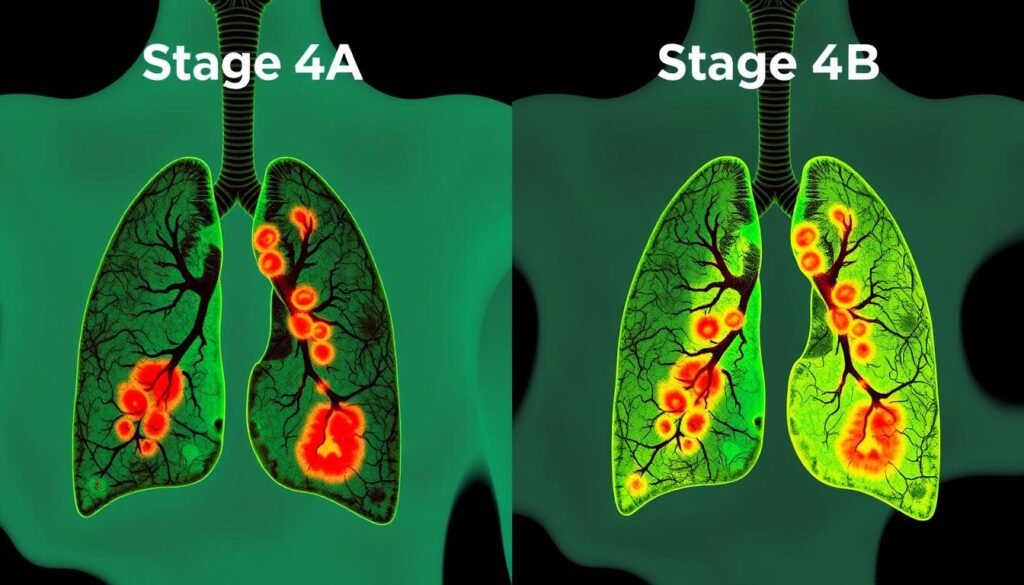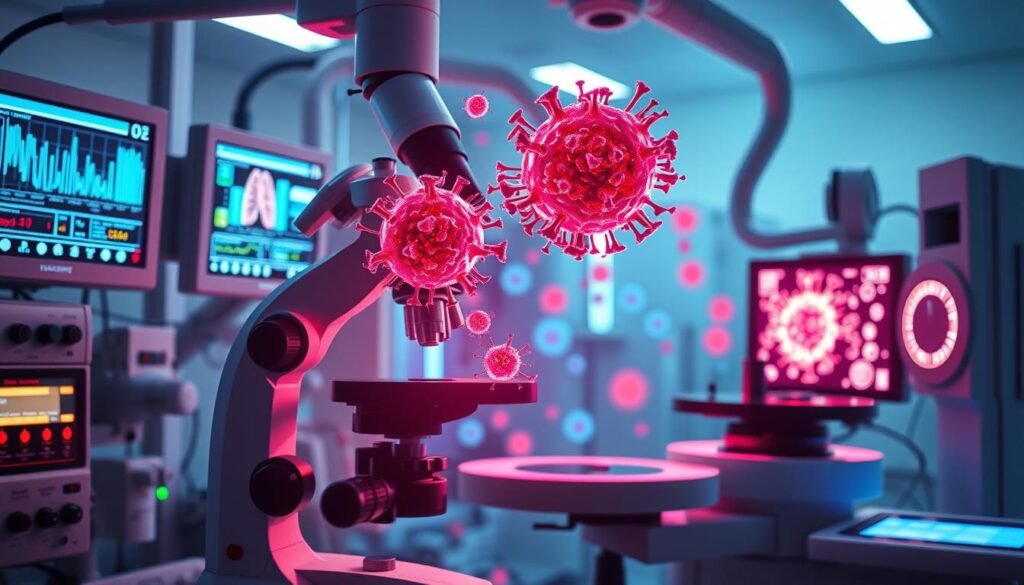About 80 to 85 percent of lung cancers are non-small cell lung cancers (NSCLC). Squamous cell carcinoma accounts for about 25 percent of these. This shows how common squamous cell lung cancer is and why we must understand its advanced stages. Stage 4 means the cancer has spread far from where it started, reaching distant parts of the body.
When facing this tough diagnosis, knowing the signs, symptoms, and how to treat it is key. Around 40 percent of people with non-small cell lung cancer are already at stage 4 when they find out. This fact underlines the importance of knowing more and catching it early. Learning about stage 4 squamous cell lung cancer helps patients and their supporters make smart choices during a hard time.
Key Takeaways
- Stage 4 squamous cell lung cancer is a serious condition marked by cancer spread to distant parts of the body.
- It represents 25 percent of all lung cancers, making it a significant subtype of non-small cell lung cancer.
- Approximately 40 percent of non-small cell lung cancer cases are metastatic at diagnosis.
- Symptoms often appear late, with common indicators including coughing, chest pain, and weight loss.
- Understanding treatment options can help in coping with the challenges of advanced lung cancer.
- The TNM staging system helps classify the extent of cancer spread, critical for treatment and prognosis.
Understanding Non-Small Cell Lung Cancer
Non-small cell lung cancer (NSCLC) is the most common type, with about 85% of cases. It differs from small cell lung cancer in its subtypes, which affect treatment. We’ll look at squamous cell carcinoma and adenocarcinoma, the main subtypes of NSCLC.
Types of Non-Small Cell Lung Cancer (NSCLC)
It’s vital to know the specific types of NSCLC for planning treatment. The two main types are:
- Squamous cell carcinoma: Starts in the flat cells lining the airways and is linked to smoking. Diagnosis involves imaging tests and tissue biopsies.
- Adenocarcinoma: Begins in the mucous glands and is more common in non-smokers. It grows slower than squamous cell carcinoma.
Classifying NSCLC is key, especially with the TNM staging system. This system helps assess:
- T – The tumor’s size and how far it has spread
- N – Whether lymph nodes are involved
- M – If there’s metastasis to distant organs
This classification helps healthcare providers accurately categorize the disease for better treatment. As medical research progresses, our understanding of NSCLC, especially the two main subtypes, is improving. This leads to enhanced care for patients.
What is Stage 4 Lung Cancer?
Stage 4 lung cancer is the most severe form of the disease. It means the cancer has spread far from the lungs. It’s also called metastatic lung cancer. This means it can affect distant lymph nodes and other body parts. Patients may have fluid around their lungs or heart, causing more problems.
The condition is split into stages 4A and 4B. Stage 4A cancer might grow into nearby places or lymph nodes. It might spread to the other lung or cover vital organs like the heart. Or, it might mean cancer has moved outside the chest.
Stage 4B shows similar growth but can affect many places outside the chest. It can reach the liver and brain. Knowing this helps us understand how serious lung cancer can be.
The TNM staging system is used to describe cancer’s spread. It looks at Tumor (T), Node (N), and Metastasis (M) progress. Terms like Any T, Any N, M1a, or M1b show how far the cancer has spread. Since about 40% of lung cancers are caught at stage 4, finding the right treatment quickly is crucial. Treatment aims to manage symptoms and improve life quality. Unfortunately, only about 4% of patients live longer than five years at this stage.
For more details on survival rates and treatments for stage 4 lung cancer, check out this guide.
Stage 4 Squamous Cell Lung Cancer: Symptoms to Watch For
Stage 4 squamous cell lung cancer comes with tough symptoms. These symptoms greatly lower a patient’s life quality. A constant cough is a key sign, often getting worse.
Many suffer from hemoptysis, or coughing up blood. This makes the disease even scarier. Chest pain is common too. It can be sharp or dull and gets worse with coughs or deep breaths.
Patients also report being tired a lot and losing weight without trying. These are signs the body is fighting hard against the cancer. When cancer spreads, people might get headaches or even seizures. They could also feel numb or weak in their arms or legs. Catching these signs early and seeing a doctor is crucial for better symptom management.
If you know the symptoms of stage 4 squamous cell lung cancer, you can act fast. Fast action means seeing a doctor early to talk about treatments.
Differences Between Stage 4A and Stage 4B NSCLC
It’s important to know the differences between stage 4A NSCLC and stage 4B NSCLC. Both are advanced forms of non-small cell lung cancer. But, they have different spread levels and prognosis.
Stage 4A NSCLC means the cancer has moved to nearby locations. This might be another lung, the pleura, or the pericardium. It could also mean there’s extra fluid in these areas or one new tumor outside the chest. Meanwhile, stage 4B NSCLC shows a more serious spread with two or more tumors outside the chest. These differences affect how doctors treat the cancer and what patients can expect.
The staging of non-small cell lung cancer is key for the right treatment. Knowing the specific stage, like 4A or 4B, helps doctors plan better treatments. Often, stage 4B requires more aggressive treatments compared to stage 4A.
This information is crucial for those with metastatic NSCLC. Knowing if one has stage 4A or 4B helps in choosing treatment paths. It also helps in understanding what the future might hold.

Prognosis and Survival Rates for Stage 4 Squamous Cell Lung Cancer
The outlook for stage 4 lung cancer is tough. Survival rates differ based on health and how well treatment works. About 8-9% of people with stage 4 squamous cell lung cancer live for five years. Most patients with this advanced cancer don’t do well, with 25-30% passing away within three months of finding out.
Age impacts survival chances. People under 50 have a five-year survival rate of around 14.2%. For those 65 or older, this drops to 5.6%. Also, women tend to live longer than men, with rates of 27% and 19.2%, respectively. These numbers show how age and gender affect survival.
To better illustrate the survival rates associated with stage 4 lung cancer, consider the following table:
| Category | Five-Year Survival Rate |
|---|---|
| Overall Stage 4 NSCLC | 8.6% (Women), 5.6% (Men) |
| Under 50 Years Old | 14.2% |
| Aged 65 and Over | 5.6% |
| Localized Stage (overall) | 65% |
| Distant Stage (overall) | 9% |
Long-term survival for stage 4 lung cancer patients is often limited. Only 15-19% live past one year. However, new treatments and personal factors can lead to better results than expected. Hence, understanding the outlook for stage 4 lung cancer is complex. It requires looking at many factors that influence survival.
Treatment Options for Advanced Lung Cancer
Treatment for stage 4 lung cancer aims to ease symptoms and slow its growth. It tries to improve the quality of life for patients. Chemotherapy and radiation therapy are key treatments.
Chemotherapy uses drugs in cycles, usually every three weeks. Drugs like cisplatin or carboplatin are common choices. Side effects may include hair loss, nausea, and skin issues.
Radiation therapy focuses on cancer areas to provide relief. It can shrink tumors, reducing pain or other problems in advanced cases.
New treatments like targeted therapy are changing the game for stage 4 lung cancer. When tumors have certain gene mutations, targeted drugs are often used first. Immunotherapy, which boosts the immune system to fight cancer, is also on the rise.

Patients should talk about all options, including trials, with their doctors. Visiting comprehensive resources helps patients make informed choices on their treatment path.
| Treatment Option | Description | Potential Side Effects |
|---|---|---|
| Chemotherapy | Combination of drugs given in cycles to target cancer cells. | Nausea, hair loss, fatigue, skin rash. |
| Radiation Therapy | Localized treatment to shrink tumors and relieve symptoms. | Skin irritation, fatigue, respiratory issues. |
| Targeted Therapy | Drugs aimed at specific genetic mutations found in the tumor. | Diarrhea, liver changes, blood clots. |
| Immunotherapy | Treatment that aids the immune system in recognizing cancer cells. | Flu-like symptoms, rashes, liver inflammation. |
Targeted Therapy for Squamous Cell Lung Cancer Stage 4
Targeted therapy is key in treating stage 4 squamous cell lung cancer. It zeroes in on specific genetic changes tied to the cancer. This can change how the cancer grows and responds to treatment. Knowing these mutations through genetic testing lets doctors create custom treatment plans.
About 5% of non-small cell lung cancers have changes in the ALK gene. Around 1% to 2% show changes in the ROS1 gene. The KRAS G12C mutation is found in roughly one in eight patients. This is key for deciding on targeted treatments. For instance, Sotorasib (Lumakras) is used for those with the KRAS G12C mutation. This is for patients who have tried other treatments.
Table summarizing key genetic mutations and corresponding targeted therapies:
| Genetic Mutation | Prevalence | Targeted Therapy |
|---|---|---|
| ALK | 5% | Alectinib |
| ROS1 | 1-2% | Crizotinib |
| KRAS G12C | Approx. 12.5% | Sotorasib (Lumakras) |
| BRAF V600E | Varies | Vemurafenib (Zelboraf) |
| FGFR alterations | 12% | FGFR kinase inhibitors |
Bevacizumab (Avastin) boosts results when used with chemotherapy and other targeted drugs. These treatments have changed how doctors treat advanced squamous cell lung cancer. They help many patients respond better to treatment. However, patients need to manage side effects like high blood pressure, headaches, and taste changes.
Research is ongoing to find more targeted therapies for squamous cell lung cancer. Using genetic info for personalized treatment is a growing area. It gives hope for improved treatment options in the future.
The Role of Immunotherapy in Treatment
Immunotherapy for lung cancer has changed how we treat stage 4 squamous cell lung cancer. It boosts the body’s immune system to fight cancer cells better. PD-L1 expression is vital for deciding if a patient can get these treatments.
Since immunotherapy was first approved in 2015, many new options have appeared. Checkpoint inhibitors attack the PD-1/PD-L1 pathway. These treatments work well for those with high PD-L1 levels, which predict how well treatment works. The NCCN suggests testing for PD-L1 in people with metastatic non-small cell lung cancer (NSCLC).

Recent research shows the progress in immune-based cancer treatments. These methods aim to improve survival rates and help with symptoms in advanced cancer. The Cancer Research Institute helps fund studies that connect genetic changes to how well patients respond.
For those with late-stage lung cancer, options like surgery and chemotherapy often don’t work well. Here, immunotherapy offers new hope. For example, patients with advanced NSCLC and high PD-L1 expression have seen good 5-year survival rates with pembrolizumab.
The importance of immunotherapy in treating cancer keeps growing. It leads to better methods and outcomes for those with stage 4 squamous cell lung cancer.
Palliative Care Options and Supportive Treatments
Palliative care is key for patients with stage 4 squamous cell lung cancer. It helps ease symptoms and improves life quality at any treatment phase. It’s useful from diagnosis to advanced stages, not just the end-of-life. Doctors, nurses, and social workers manage the tough symptoms of lung cancer together.
Supportive treatments help improve patient comfort in many ways. They might include removing fluid from around the lung or using stents to keep airways open. These methods help manage issues like breathlessness. Palliative treatments are focused on easing cancer-related discomfort.
Care also covers emotional support, better nutrition, and wellness techniques like mindfulness. These services help with the mental and physical struggles of treatment. Such comprehensive care looks after the patient’s total well-being.
Palliative care is offered in many places like hospitals and clinics. This flexibility highlights its role in improving life for those with advanced lung cancer. It combines medical and emotional support, helping patients deal with their illness gracefully.
Clinical Trials: A Hope for Treatment Advancement
Clinical trials are key in the ongoing fight against advanced lung cancer. They offer patients access to new therapies not yet available to the public. This gives patients access to the latest treatments and helps with medical research.
Clinical trials mainly test targeted therapies or immunotherapies. These treatments have seen huge breakthroughs recently, especially for lung cancer. For instance, checkpoint inhibitors boost the immune system’s ability to destroy cancer cells. This has helped many patients with non-small cell lung cancer.
Patients in clinical trials can try new treatments that might work better than old ones. The Willamette Valley Cancer Institute is where doctors conduct research to find better lung cancer treatments. These trials improve how we treat lung cancer and increase our understanding of it.
- Access to innovative therapies
- Contribution to medical research
- Improvement in treatment outcomes
- Potential for participation in multimodal therapy approaches
Before joining a clinical trial, talk with your doctor. It’s important to know if you qualify and understand the risks. Being in a trial means you could get advanced treatment for lung cancer. It also means you’re helping improve treatment for others in the future.
Conclusion
Knowing about stage 4 squamous cell lung cancer is crucial for patients and their families. They face a tough journey. There are treatments like chemotherapy, targeted therapy, and immunotherapy. These are designed to fit each person’s needs.
This approach helps to improve survival rates. It also aims to make life better through care and support.
Research into lung cancer treatment is ongoing and brings hope. It points towards a future where medicine is more personalized. Despite the challenges of stage 4 lung cancer, new therapies offer optimism.
Patients can manage their disease better by keeping up with their healthcare teams. Making informed treatment decisions is key to their journey.
Staying connected with support networks is important. It can ease the burden of cancer’s emotional and physical stress. Working together, patients and caregivers can navigate the challenges of stage 4 lung cancer. They also maintain hope for advancements in lung cancer care.